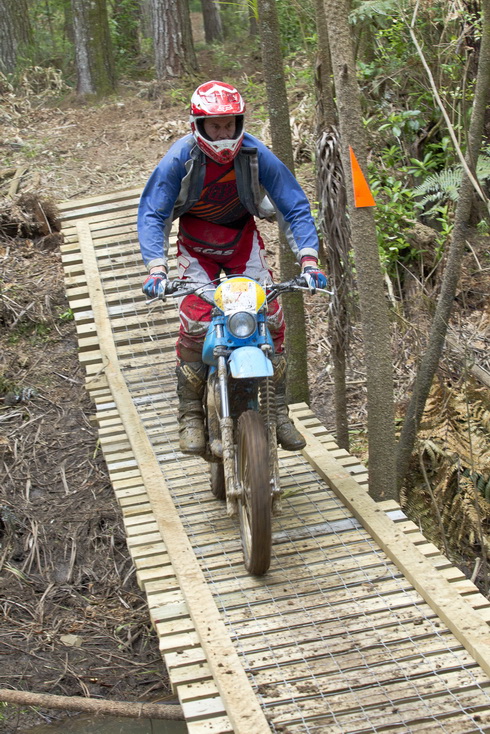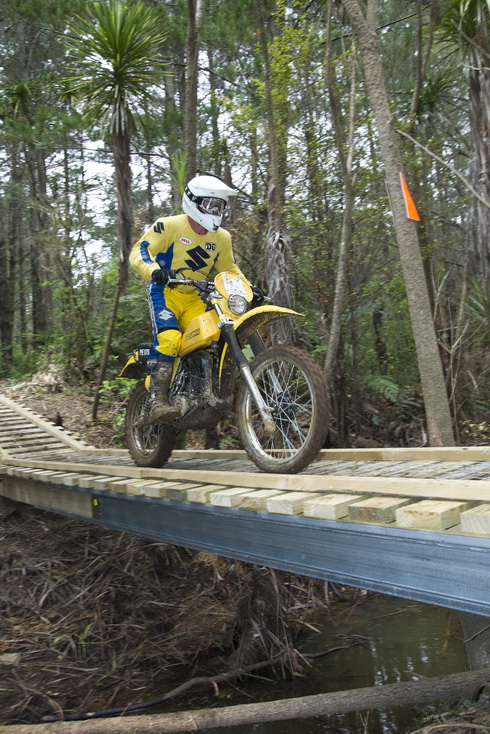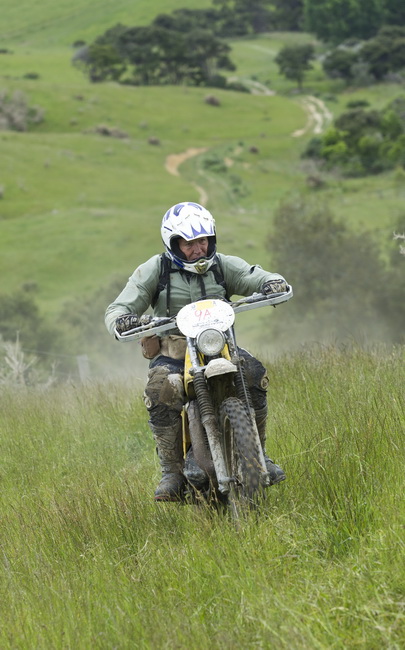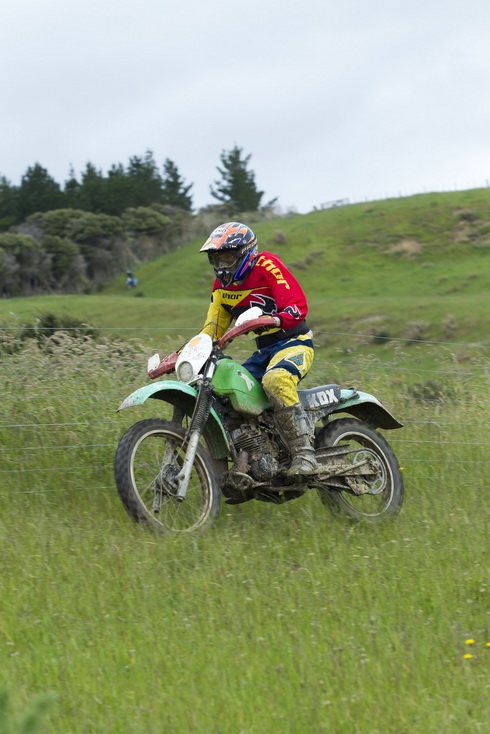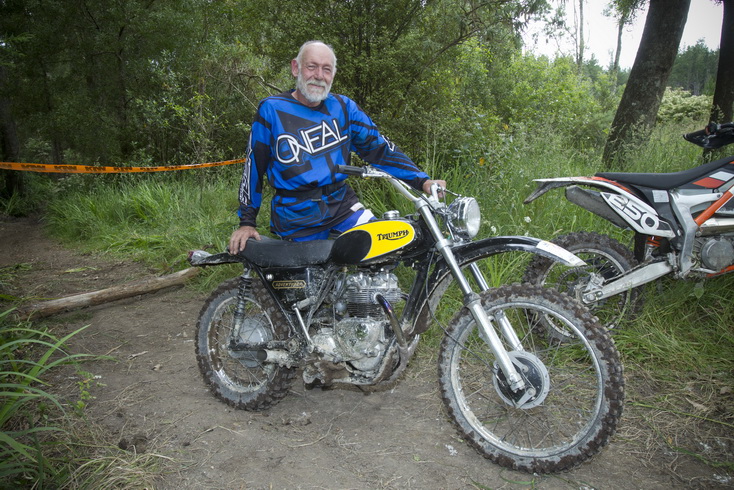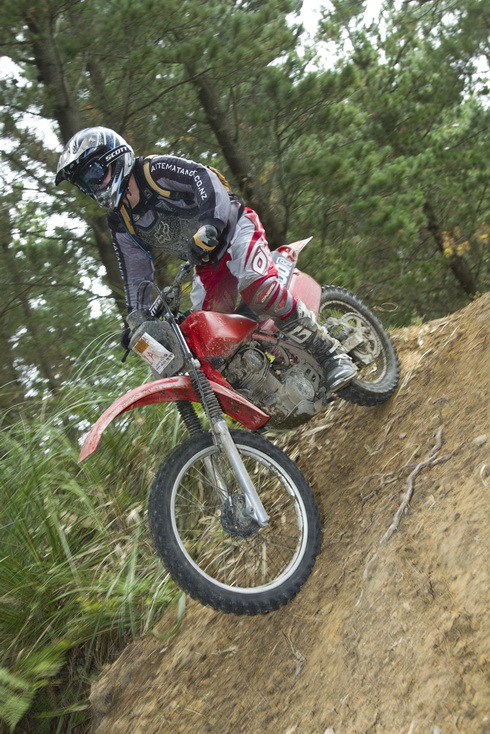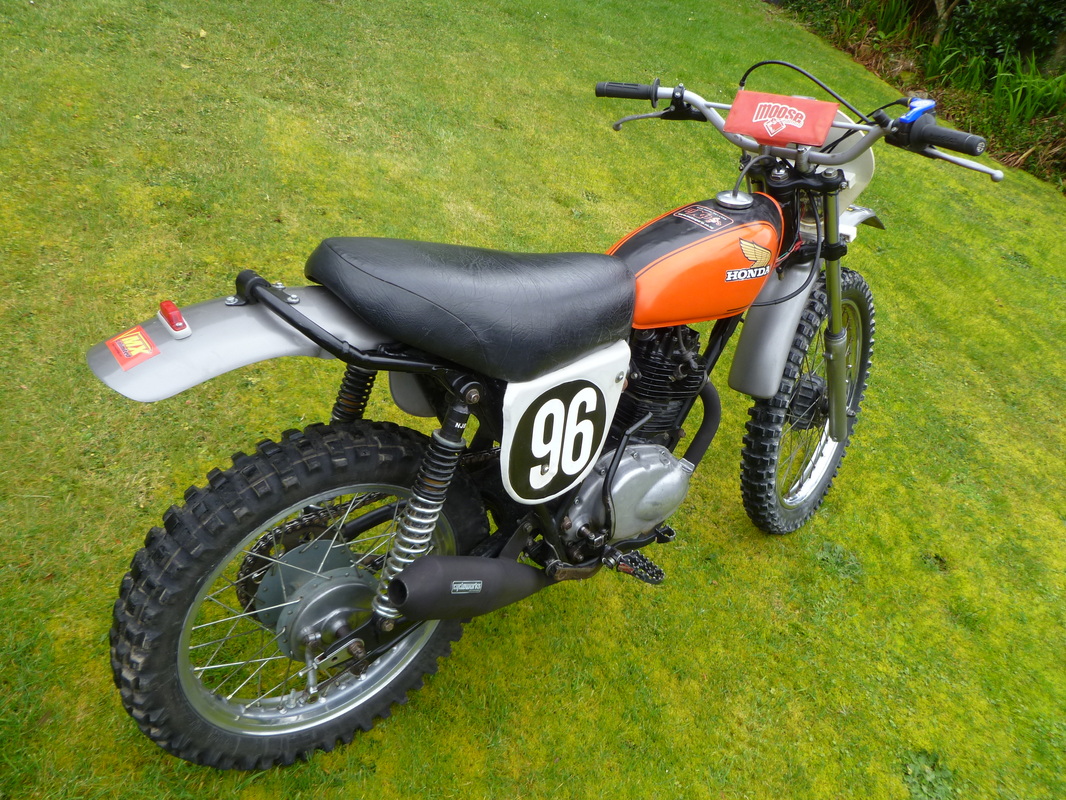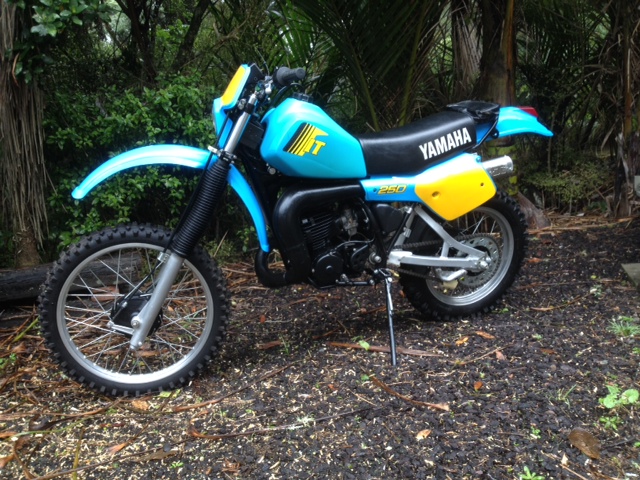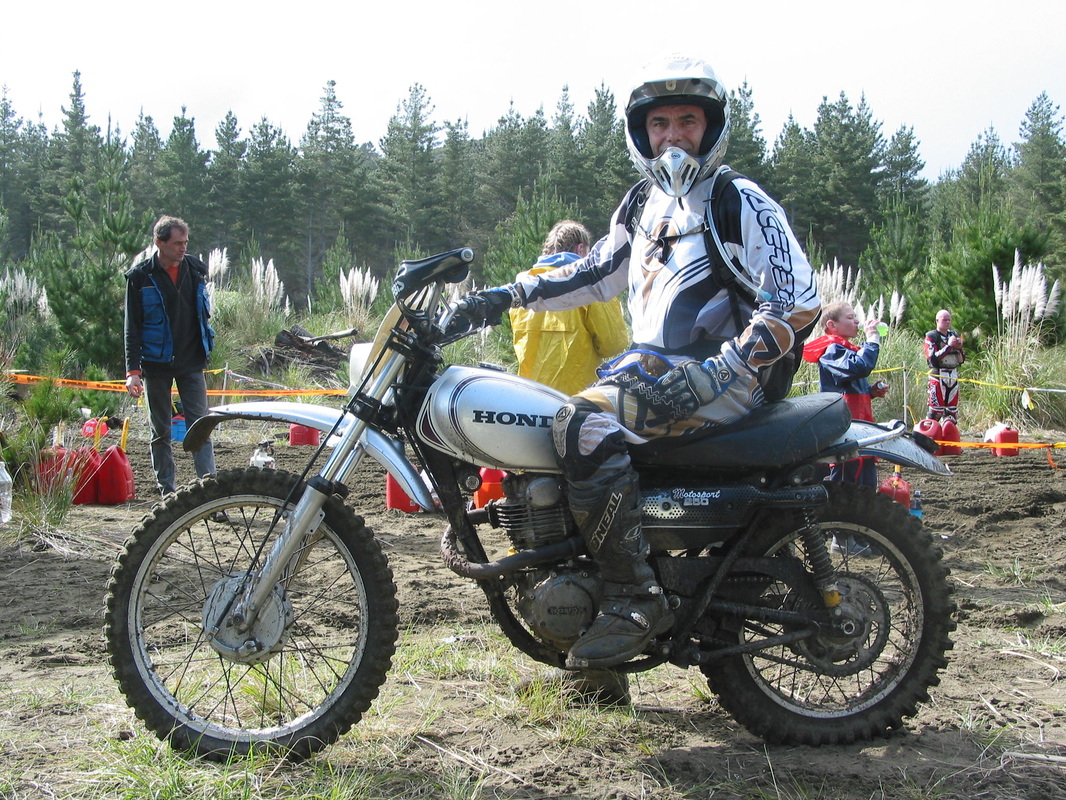WHICH VINDURO?
In this section we take a look at some of the popular Vinduro machines and consider what they may be like to own and ride.
WHICH PERIOD?
Whichever route you take towards your first Vinduro bike you are going to have to consider what period of machine you would like. Vinduro bikes span many decades of dirt riding, from the four speed dinosaurs of the late sixties to the relative sophistication of the dual disc-braked, liquid cooled, power valve race bikes of the mid nineties.
While the late model Modern class bikes are quite like contemporary bikes in terms of performance and ride comfort as you go back in time through the classes its a far different situation. With each step back on the timeline, engine and suspension performance becomes markedly inferior. Suspension systems underwent immense improvements during the late seventies and early eighties, so that riding any short travel bike in off-road conditions is a reality check for riders used to modern bikes. You simply cant go as fast as you have become used to going and you will find that the lack of suspension travel and sophistication beats up your body far more than your modern bike ridden at twice the speed. If you can't lower your performance expectations and adapt your riding technique you may simply never enjoy the experience, and this is especially so on the older period bikes. From this comment you might think that most riders would gravitate to the later model classes, but this is not so, as many riders do in fact enjoy the challenge of riding an old dirt bike and keeping the flag flying for older periods.
Anyone who expects their Vinduro ride to be trouble-free will be disappointed, even the newest bikes are obsolete models now. Parts need to be sourced from the Internet, sometimes it will take months for a hard to find item to crop up and patience is required.
Of course the difficulties involved won’t deter the real Vinduro enthusiast, the challenge of restoring and maintaining a vintage machine is part of the appeal. The thrill however is getting your vintage wheels out on a nice trail, hearing the ring of an air-cooled engine, owning and riding the bike that for someone was once the stuff of dreams.
FINDING A BIKE
It’s an unfortunate reality that tidy examples of enduro bikes are getting harder to find in NZ. Though truckloads were sold the reality is that most of these bikes were ridden virtually to destruction by generations of riders. Even without misuse mud, slush and cow shit helped do the worst. That said, good examples are still plucked out of barns and increasingly out of the sheds of collectors who are moving on.
Though the price of a restored or original enduro bike ranges from about 3-6K the cost of buying a good example is usually no more, often less than what you would spend to bring a rust bucket up to standard. For those who enjoy the challenge there’s nothing as satisfying as turning mechanical junk into gold, but also consider the broken dreams of blokes who lacked either the skill, budget or perseverance to finish the job.
Many enthusiasts have been importing vintage enduro bikes from the USA. In that giant land of excess there seem to be plenty of bikes still coming to the surface. Freight adds to the price, but it’s not a very complicated process to import an off road dirt bike into NZ.
I am also inviting riders to e mail me photos and descriptions of their trail, Vinduro or VMX ride to share with other enthusiasts. Bikes can be showroom condition or well used, it makes no matter, so long as they are old enough to be interesting or even a project you may have underway, or on the ten year plan. Send your pics and a bit of info to [email protected] files must be jpegs (.jpg) ideally between 500k and 1 meg.
WHICH PERIOD?
Whichever route you take towards your first Vinduro bike you are going to have to consider what period of machine you would like. Vinduro bikes span many decades of dirt riding, from the four speed dinosaurs of the late sixties to the relative sophistication of the dual disc-braked, liquid cooled, power valve race bikes of the mid nineties.
While the late model Modern class bikes are quite like contemporary bikes in terms of performance and ride comfort as you go back in time through the classes its a far different situation. With each step back on the timeline, engine and suspension performance becomes markedly inferior. Suspension systems underwent immense improvements during the late seventies and early eighties, so that riding any short travel bike in off-road conditions is a reality check for riders used to modern bikes. You simply cant go as fast as you have become used to going and you will find that the lack of suspension travel and sophistication beats up your body far more than your modern bike ridden at twice the speed. If you can't lower your performance expectations and adapt your riding technique you may simply never enjoy the experience, and this is especially so on the older period bikes. From this comment you might think that most riders would gravitate to the later model classes, but this is not so, as many riders do in fact enjoy the challenge of riding an old dirt bike and keeping the flag flying for older periods.
Anyone who expects their Vinduro ride to be trouble-free will be disappointed, even the newest bikes are obsolete models now. Parts need to be sourced from the Internet, sometimes it will take months for a hard to find item to crop up and patience is required.
Of course the difficulties involved won’t deter the real Vinduro enthusiast, the challenge of restoring and maintaining a vintage machine is part of the appeal. The thrill however is getting your vintage wheels out on a nice trail, hearing the ring of an air-cooled engine, owning and riding the bike that for someone was once the stuff of dreams.
FINDING A BIKE
It’s an unfortunate reality that tidy examples of enduro bikes are getting harder to find in NZ. Though truckloads were sold the reality is that most of these bikes were ridden virtually to destruction by generations of riders. Even without misuse mud, slush and cow shit helped do the worst. That said, good examples are still plucked out of barns and increasingly out of the sheds of collectors who are moving on.
Though the price of a restored or original enduro bike ranges from about 3-6K the cost of buying a good example is usually no more, often less than what you would spend to bring a rust bucket up to standard. For those who enjoy the challenge there’s nothing as satisfying as turning mechanical junk into gold, but also consider the broken dreams of blokes who lacked either the skill, budget or perseverance to finish the job.
Many enthusiasts have been importing vintage enduro bikes from the USA. In that giant land of excess there seem to be plenty of bikes still coming to the surface. Freight adds to the price, but it’s not a very complicated process to import an off road dirt bike into NZ.
I am also inviting riders to e mail me photos and descriptions of their trail, Vinduro or VMX ride to share with other enthusiasts. Bikes can be showroom condition or well used, it makes no matter, so long as they are old enough to be interesting or even a project you may have underway, or on the ten year plan. Send your pics and a bit of info to [email protected] files must be jpegs (.jpg) ideally between 500k and 1 meg.
WHAT TO EXPECT OF EACH CLASS
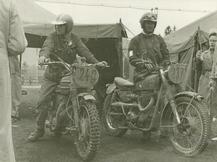
VINTAGE
The most challenging bikes to ride and the rarest of all of them all as very few of the four speed off road bikes were ridden beyond the scrambles tracks in NZ though in Europe, especially Germany and the UK more have survived. So far only one Vintage bike has finished a Vinduro in NZ. I sincerely hope that some enthusiasts will be inspired to build bikes. The class will in the meantime be retained as a memory to the machines and men who pioneered off road enduro riding. (see the story on Tim Gibbes ISDT Gold Medals for inspiration).
The most challenging bikes to ride and the rarest of all of them all as very few of the four speed off road bikes were ridden beyond the scrambles tracks in NZ though in Europe, especially Germany and the UK more have survived. So far only one Vintage bike has finished a Vinduro in NZ. I sincerely hope that some enthusiasts will be inspired to build bikes. The class will in the meantime be retained as a memory to the machines and men who pioneered off road enduro riding. (see the story on Tim Gibbes ISDT Gold Medals for inspiration).
YAMAHA IT175 - EVO 1
Craig Brown's day-to-day motorcycling is firmly in the modern world but one of his passions is Vinduro bikes, and Yamaha’s Evo 1 Class IT175 is his favourite. In 1977 Yamaha stunned the enduro world with the IT (International Trial) range. The bikes were a triumph of enduro sophistication with a boggling array of ‘but wait, there’s more’ details.
By 1982, when this IT hit the market, the 175 was several models old and the little engine had filled out in the bottom and mid range, and the suspension had improved and grown in travel. All this made for a lightweight, fast, decent handling package with a good balance of performance in tight and open conditions.
The IT 175 continued improving through the eighties with the introduction of rising rate suspension up to the disc braked IT200 when the rug was cruelly whipped out from the market and the IT range discontinued.
With a good number of IT’s still about there are a number of parts specialists making new items like plastic, exhausts, brakes etc, though gearbox parts especially are getting more difficult to find. The IT 250 and 465/490 models offer increased power, at the cost of slower steering response and increased weight. Evo 1 bikes with their first generation long travel suspension are markedly easier to ride than bikes of the classic period and have more clearance in ruts made by modern bikes.
By 1982, when this IT hit the market, the 175 was several models old and the little engine had filled out in the bottom and mid range, and the suspension had improved and grown in travel. All this made for a lightweight, fast, decent handling package with a good balance of performance in tight and open conditions.
The IT 175 continued improving through the eighties with the introduction of rising rate suspension up to the disc braked IT200 when the rug was cruelly whipped out from the market and the IT range discontinued.
With a good number of IT’s still about there are a number of parts specialists making new items like plastic, exhausts, brakes etc, though gearbox parts especially are getting more difficult to find. The IT 250 and 465/490 models offer increased power, at the cost of slower steering response and increased weight. Evo 1 bikes with their first generation long travel suspension are markedly easier to ride than bikes of the classic period and have more clearance in ruts made by modern bikes.
SUZUKI PE 175 - Evo 1
The PE 175 C was Neville Coombe’s first new bike, a purchase that would lead to a lifetime of racing dirt bikes and a NZ Hare Scrambles title. Neville runs a small fleet of Suzukis and this Evo 1 Class PE is one of his all time favourites.
Released in 1977 and based on the RM 250 motocrosser, the PE 250B was Suzuki’s big jump into the world of specialist enduros. The PE 175C, based on the RM 125, followed in 1978. The PE175 (pure enduro) was a classy enduro bike, nimble handling, very light (under 100kg) and until the revamped T model in 1980, had a moderate seat height. In the right hands the PE was an event winner, but the bikes were easy to ride and were as popular with part-time racers and trail riders. In 1980 a 400cc version was added to the range, but by 1983 the Japanese flirtation with the enduro world was over and the model range was pulled from a distraught market.
Considering their popularity in the day good PEs are getting scarce in NZ. Being relatively simple bikes they are easy enough to keep going with replica plastics and consumables readily available. The PE twin shock models run very competitively in the Evo 1 class.
Released in 1977 and based on the RM 250 motocrosser, the PE 250B was Suzuki’s big jump into the world of specialist enduros. The PE 175C, based on the RM 125, followed in 1978. The PE175 (pure enduro) was a classy enduro bike, nimble handling, very light (under 100kg) and until the revamped T model in 1980, had a moderate seat height. In the right hands the PE was an event winner, but the bikes were easy to ride and were as popular with part-time racers and trail riders. In 1980 a 400cc version was added to the range, but by 1983 the Japanese flirtation with the enduro world was over and the model range was pulled from a distraught market.
Considering their popularity in the day good PEs are getting scarce in NZ. Being relatively simple bikes they are easy enough to keep going with replica plastics and consumables readily available. The PE twin shock models run very competitively in the Evo 1 class.
SUZUKI TS 250 - Classic
Kevin is one of those old school enduro riders who grew up on British machines; in fact Kevin rode NZ’s first enduro at Raglan in 1974 on an Ariel 500 single.
You might be thinking that a Suzuki TS250 trail bike is an unusual Vinduro choice, but then Kevin will tell you otherwise. The TS250 introduced in 1970 had an engine tuned for strong low-end power . Early models had piston port engines and basic suspension, but improvements came with a reed valve engine, partially laid down shocks and improved forks. Kevin's 1982 model TS250 running in the Vintage class was virtually the last incarnation. By the late 70s the specialist PE models had taken over, but where a trail bike like the TS250 loses out in top end power and suspension performance it does have a low seat height and all-round lugging ability that makes for a bike that’s effective in tighter conditions.
Kevin has concentrated on removing the excess trail bike weight from the bike and replacing components where necessary with lighter, less vulnerable items.
Because many trail bikes don’t go seriously off road there are still good examples to be found, usually at modest asking prices, so there are still some bargains to be had. Suzuki’s TS 185 is a lighter and equally effective option.
As Kevin showed by winning the Overall handicap at the VSE, the combination of experience and a humble trail bike can be an irresistible force.
You might be thinking that a Suzuki TS250 trail bike is an unusual Vinduro choice, but then Kevin will tell you otherwise. The TS250 introduced in 1970 had an engine tuned for strong low-end power . Early models had piston port engines and basic suspension, but improvements came with a reed valve engine, partially laid down shocks and improved forks. Kevin's 1982 model TS250 running in the Vintage class was virtually the last incarnation. By the late 70s the specialist PE models had taken over, but where a trail bike like the TS250 loses out in top end power and suspension performance it does have a low seat height and all-round lugging ability that makes for a bike that’s effective in tighter conditions.
Kevin has concentrated on removing the excess trail bike weight from the bike and replacing components where necessary with lighter, less vulnerable items.
Because many trail bikes don’t go seriously off road there are still good examples to be found, usually at modest asking prices, so there are still some bargains to be had. Suzuki’s TS 185 is a lighter and equally effective option.
As Kevin showed by winning the Overall handicap at the VSE, the combination of experience and a humble trail bike can be an irresistible force.
KAWASAKI KDX200 Evo 2
Neil Coopers had this 1984 KDX200 C1 from new, though the bike hasn’t been used much for many years. The VSE was just the reason Neil was keeping this bike and another just like it that his son rode.
Kawasaki’s KDX was released among the second wave of the specialist Japanese enduro bikes. Replacing the KDX175 the 200 added improved suspension and considerable engine punch in the low to mid range, yet retained the ultra light weight of many bikes of the period.
The KDX 200 proved to be just about the perfect bike for hard NZ conditions, light, agile and virtually bulletproof. Though the tiny drum brakes are very underdone by today’s standards, with decent rising rate rear suspension and supple long travel forks the KDX can still get along very well. Later model air-cooled KDXs gained disc front brakes and engine power valves and flat slide carb and the C3 model is surprisingly peppy. Once found, a good KDX will be reasonably easy to maintain and continue to give good service for generations to come. The larger and more bulky KDX 250 and 420 models are more rare in NZ.
Kawasaki’s KDX was released among the second wave of the specialist Japanese enduro bikes. Replacing the KDX175 the 200 added improved suspension and considerable engine punch in the low to mid range, yet retained the ultra light weight of many bikes of the period.
The KDX 200 proved to be just about the perfect bike for hard NZ conditions, light, agile and virtually bulletproof. Though the tiny drum brakes are very underdone by today’s standards, with decent rising rate rear suspension and supple long travel forks the KDX can still get along very well. Later model air-cooled KDXs gained disc front brakes and engine power valves and flat slide carb and the C3 model is surprisingly peppy. Once found, a good KDX will be reasonably easy to maintain and continue to give good service for generations to come. The larger and more bulky KDX 250 and 420 models are more rare in NZ.
TRIUMPH TR5T - Vintage
Perhaps the ultimate challenge in the world of Vinduro is to ride a Vintage class four-speed machine in a real enduro. This is the mission that veteran rider Peter Groves set about riding this relatively rare TR5T in the Vintage Class.
The task was made all the more difficult because the bike was only back on its wheels hours before the VSE after a total re-build, having spent the previous thirty years as a living room ornament.
The TR5T was just the second and the final true dirt bike built by the Meriden factory, the first being the ISDT replica TR5 Trophy.
Despite the motor’s origins harking from the 1930s the TR5T is a better dirt bike than you might imagine. The oil-bearing frame at least was modern in the early 1970s though the the heavy four-speed twin cylinder engine was not. What the engine did provide however was a decent low to mid range power that gave great traction in slippery conditions and the ability to rev to a reasonable extent.
When most TR5Ts are nowdays very much show ponies it’s to Peter’s great credit that this bike is back out in its real element tackling enduro conditions.
Other likely options in this class are the early 4 speed Huskies, CZ singles and twins, BSA 441 and 250 singles, Triumph Tiger Cub and any of the Villiers based British two strokes.
The task was made all the more difficult because the bike was only back on its wheels hours before the VSE after a total re-build, having spent the previous thirty years as a living room ornament.
The TR5T was just the second and the final true dirt bike built by the Meriden factory, the first being the ISDT replica TR5 Trophy.
Despite the motor’s origins harking from the 1930s the TR5T is a better dirt bike than you might imagine. The oil-bearing frame at least was modern in the early 1970s though the the heavy four-speed twin cylinder engine was not. What the engine did provide however was a decent low to mid range power that gave great traction in slippery conditions and the ability to rev to a reasonable extent.
When most TR5Ts are nowdays very much show ponies it’s to Peter’s great credit that this bike is back out in its real element tackling enduro conditions.
Other likely options in this class are the early 4 speed Huskies, CZ singles and twins, BSA 441 and 250 singles, Triumph Tiger Cub and any of the Villiers based British two strokes.
HONDA XR 200 - Evo 2
John Buxton’s Evo 2 Class XR 200 lives in the shed aside a fleet of new KTMs. The XR was the bike John really wanted when he was 16, so the little Honda was an easy Vinduro choice for him.
Purchased on Trade Me the XR was in pretty good order needing only a general tidy up and replacement of usual high wear items, and a full suspension re-build that included fitting Emulator valves to the forks.
The two valve XR 200s were a popular bike in NZ, at times the top seller, so many have survived. The XR was also a very endearing bike and their owners usually loved them despite never having quite enough power and a soft clutch. The XR200 has a short wheelbase making it especially capable in tight going, and the suspension, while not confidence-inspiring at high speed, was comfortable.
In 1985 Honda replaced the XR200 with a twin carb four-valve model. Though much faster the new bike shared a chassis with the 250 and never felt like a true small bore bike again. It was also unreliable, so in 1986 Honda went back to the future with the old two-valve engine. In various guises versions the XR 200 soldiered on almost to this day making most parts reasonably plentiful. The current Honda CRF230 play bike owes much of it's bones to the venerable XR200.
Purchased on Trade Me the XR was in pretty good order needing only a general tidy up and replacement of usual high wear items, and a full suspension re-build that included fitting Emulator valves to the forks.
The two valve XR 200s were a popular bike in NZ, at times the top seller, so many have survived. The XR was also a very endearing bike and their owners usually loved them despite never having quite enough power and a soft clutch. The XR200 has a short wheelbase making it especially capable in tight going, and the suspension, while not confidence-inspiring at high speed, was comfortable.
In 1985 Honda replaced the XR200 with a twin carb four-valve model. Though much faster the new bike shared a chassis with the 250 and never felt like a true small bore bike again. It was also unreliable, so in 1986 Honda went back to the future with the old two-valve engine. In various guises versions the XR 200 soldiered on almost to this day making most parts reasonably plentiful. The current Honda CRF230 play bike owes much of it's bones to the venerable XR200.
- Evo 1YAMAHA TT250 G
Here's another of Andrew Robertson's bikes, aN Evo 1 Class Yamaha TT250G. In Andrew's words. "This is my everyday trail ride bike. Again its dressed up for the period - more 1977/78 style. To me this was a very innovative period where riders were modding their bikes to the max. Since I was a Manawatu boy I was always inspired by local riders. I always remember Peter Van Dinegens bike, a YZ 125C with a TY 175 engine - so cool! I haven't done much too this bike other than big bore the engine to 300cc and ported the head.
HONDA XL175 - Classic
Here's Andrew Roberston's Classic Class Honda XL 175. 'The bike started out very rough hack but over the last few years Andrew has dressed it up and warmed the engine! Its running NJB shocks from the UK, later model XL 125 forks (couldn't find any CR 125 forks), a Cycleworks pipe, big bore engine, ported head, roller bearing cam, a 28mm Keihen carb, Preston Petty headlight and CR 125 Elsinore plastics. .
As for many Vinduro enthusiasts the XL175 was the bike Andrew wanted to own when he was a teenager. Having one now he’s got a job on his hands because riding and maintaining a forty year old dirt bike takes perseverance.
Though the XL175 was a sweet looking machine the Honda four strokes of the period were relatively heavy dual-purpose trail bikes, not competition enduros. The smaller XLs especially also lacked real power.
With short travel rear suspension and a five-speed gearbox the XL175 qualifies for the second oldest class, the Classics. Riding a short travel bike poses challenges, bumps have to be taken more slowly and they can be tiring in rough terrain. Line choice is critical as foot peg clearance is not as good as more modern machines.
Enthusiasts of the Classic Hondas can also consider the XL250 and 350 Motosport models. Though somewhat heavier again the larger four valve models produce far more power.
As for many Vinduro enthusiasts the XL175 was the bike Andrew wanted to own when he was a teenager. Having one now he’s got a job on his hands because riding and maintaining a forty year old dirt bike takes perseverance.
Though the XL175 was a sweet looking machine the Honda four strokes of the period were relatively heavy dual-purpose trail bikes, not competition enduros. The smaller XLs especially also lacked real power.
With short travel rear suspension and a five-speed gearbox the XL175 qualifies for the second oldest class, the Classics. Riding a short travel bike poses challenges, bumps have to be taken more slowly and they can be tiring in rough terrain. Line choice is critical as foot peg clearance is not as good as more modern machines.
Enthusiasts of the Classic Hondas can also consider the XL250 and 350 Motosport models. Though somewhat heavier again the larger four valve models produce far more power.
YAMAHA IT 250 - Evo 1
Here's a tidy 1982 Evo 1 Class Yamaha IT250 that still gets used in the forest. Though the IT 250 was not as popular as the more nimble IT175 here in NZ, it was a superb enduro bike. The IT (International Trial) featured many detail touches to make ithe bike totally enduro ready including: quick release wheels and air rapid filter access. The IT has a well-spaced six speed gearbox and produces great all round power, but has typical slow steering of the time making it a bit ponderous in tight going with the massive fuel tank making it hard for the rider to keep forward. IT riders learn to lean the bike in turns or skid the rear wheel to negate understeer.
By 1982 the IT 250 had become taller with 12 inches of suspension travel and this was the last model with a non linkage monoshock. Owning and restoring an IT today is made easier by companies like DVCMX https://www.dcvmx.com who can supply most consumables and plastic. Like many 80s bikes gearbox items are becoming harder to find.
By 1982 the IT 250 had become taller with 12 inches of suspension travel and this was the last model with a non linkage monoshock. Owning and restoring an IT today is made easier by companies like DVCMX https://www.dcvmx.com who can supply most consumables and plastic. Like many 80s bikes gearbox items are becoming harder to find.
HONDA XL 250 MOTOSPORT - Classic
Here's my own much - loved and well used Honda XL250 Motosport. The XL was a cult bike here in NZ in the early 70s and was used by young fellas for day to day transport, weekend trailriding and for enduro and club MX racing. The XL was overweight and it wasn't fast in any terms, but it did climb hills superbly well and if you made it a rule to never use the brakes, even in emergencies, it could be moved along surprisingly fast if revved hard, which it could do all day.
In deep mud the XL can be very energy sapping and hard to budge if stuck. That said in expert hands the XL 250 (and 350) won several title in the early days of enduros in NZ.
Blair (Horrie) Harrison was the finest natural rider I have know and the consummate XL250 rider, both in MX, stunting and enduro. Horrie won the first NZ Enduro Champs on an XL250 in 1975. This photo was taken at the 30th the Dead Toad and I rode the bike again at the 40th DT and was out on the course at the 40th VSE. This bike is typical of how we set up an XLs back in the day with a Preston Petty plastic headlight, small tail light and Koni shocks. There's more on my XL250 elsewhere in this section.
In deep mud the XL can be very energy sapping and hard to budge if stuck. That said in expert hands the XL 250 (and 350) won several title in the early days of enduros in NZ.
Blair (Horrie) Harrison was the finest natural rider I have know and the consummate XL250 rider, both in MX, stunting and enduro. Horrie won the first NZ Enduro Champs on an XL250 in 1975. This photo was taken at the 30th the Dead Toad and I rode the bike again at the 40th DT and was out on the course at the 40th VSE. This bike is typical of how we set up an XLs back in the day with a Preston Petty plastic headlight, small tail light and Koni shocks. There's more on my XL250 elsewhere in this section.
Send your pics and a bit of info to [email protected] files must be jpegs (.jpg) ideally between 500k and 1 meg.
